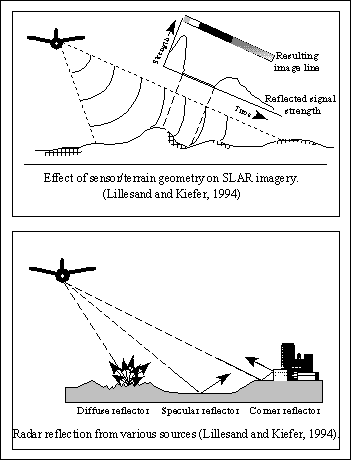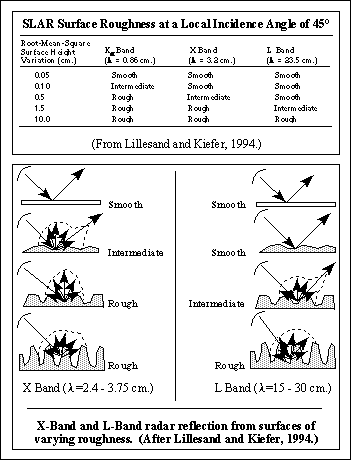![]()

Since the atmosphere is transparent to most microwavelengths, these signals may be employed for all-weather monitoring. However, wavelengths smaller than about 3 cm. may be attenuated or dispersed by the atmosphere. Radar is used to locate the position and intensity of precipitation systems because raindrops can reflect radar signals significantly. The echoes produced by such weather systems are proportional to the size of the individual raindrops.
When using wavelengths longer than 3 cm., and in the absence of rain, Earth surface features influence the reflection or scatter of incident radar waves. In the diagram (top) the influence of terrain geometry on sensor reception is shown. Slopes at near-orthogonal orientations to the incident radar pulse will generally reflect the energy intensely. The strength of the return signal from these gradients is translated into a "bright" response on the final image. Those areas that are blocked from radar "illumination" will yield no return at all. These areas will translate into totally black areas on the radar image. (Note that areas "in shadow" on photographic images show some reflectance, due to the scattering of light.) The very high contrast results of many radar images are due to these geometric phenomena.
![]()
Surface characteristics of a smaller scale also affect radar return signals. Surface roughness may be inferred by the wavelength transmitted and the qualities of the reflected waves. Surfaces are considered "rough" when the root-mean-square (rms) height of the surface variations exceeds one-eighth of the wavelength of sensing (wavelength/8) divided by the cosine of the local incidence angle (Lillesand and Kiefer, 1994).
In the diagram above (bottom) the instrument would gather significant radar echoes from the "rough" surface below, but would receive no reflected energy from the "smooth" surface. Such surfaces, also known as "specular reflectors" are defined as those features with rms height variation of less than wavelength/8 divided by the cosine of the incidence angle. Particularly strong signals are acquired by "corner reflectors," where the incident energy is reflected twice in such a way that almost all of it is directed back to the sensor. Anthropogenic structures such as buildings may appear as extremely bright features on radar images due to this phenomenon, depending on the look angle of the radar and orientation of the ground features.
![]()

A surface appearing "rough" in a short wavelength will appear "smoother" when a longer wavelength signal is utilized. The diagram here shows the difference in reflectance characteristics (and inferred surface roughness) when using X and L band radars.
![]() Return to Hunter's Terrain Analysis Home Page
Return to Hunter's Terrain Analysis Home Page